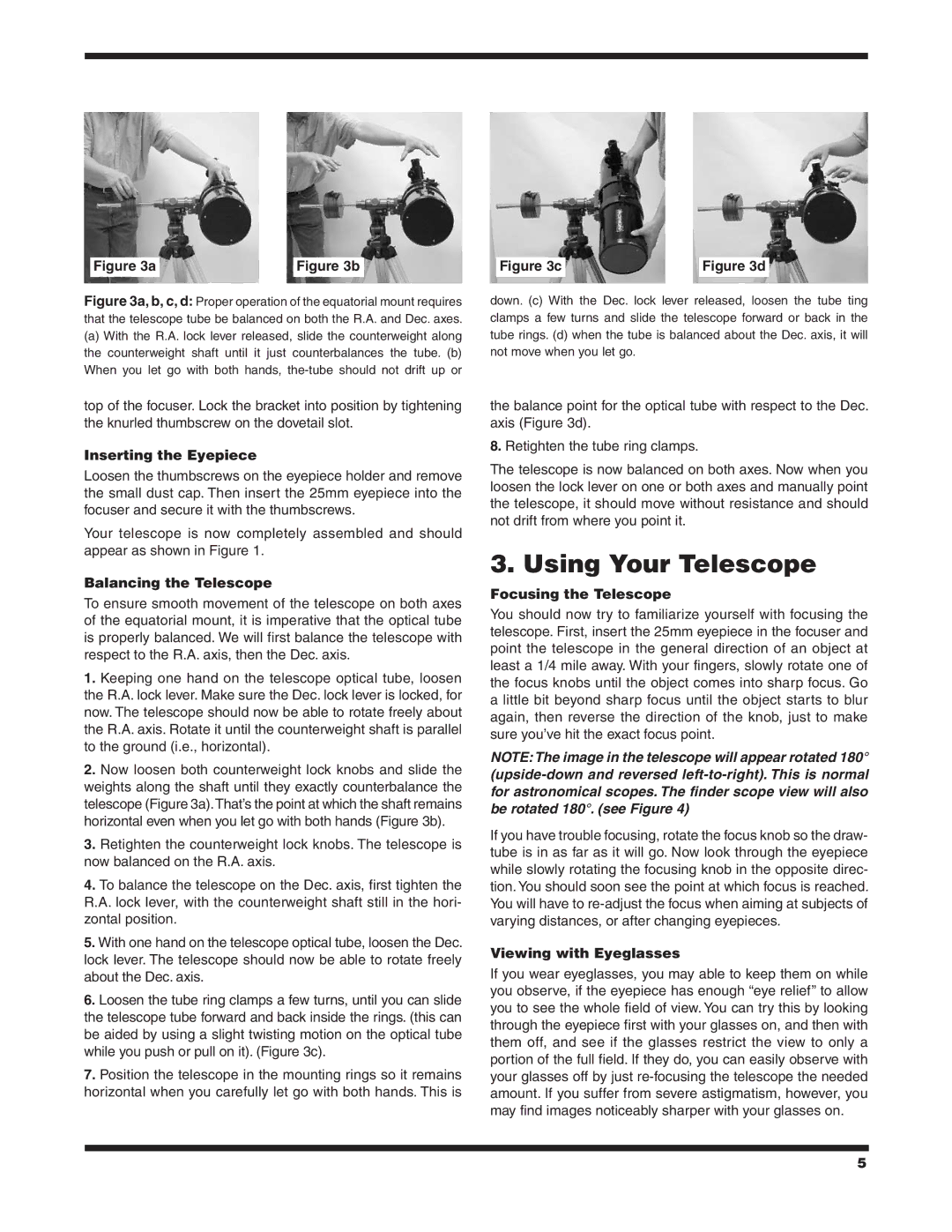
Figure 3a |
| Figure 3b |
| Figure 3c |
| Figure 3d |
|
|
|
|
|
|
|
Figure 3a, b, c, d: Proper operation of the equatorial mount requires that the telescope tube be balanced on both the R.A. and Dec. axes.
(a)With the R.A. lock lever released, slide the counterweight along the counterweight shaft until it just counterbalances the tube. (b) When you let go with both hands, the‑tube should not drift up or
down. (c) With the Dec. lock lever released, loosen the tube ting clamps a few turns and slide the telescope forward or back in the tube rings. (d) when the tube is balanced about the Dec. axis, it will not move when you let go.
top of the focuser. Lock the bracket into position by tightening the knurled thumbscrew on the dovetail slot.
Inserting the Eyepiece
Loosen the thumbscrews on the eyepiece holder and remove the small dust cap. Then insert the 25mm eyepiece into the focuser and secure it with the thumbscrews.
Your telescope is now completely assembled and should appear as shown in Figure 1.
Balancing the Telescope
To ensure smooth movement of the telescope on both axes of the equatorial mount, it is imperative that the optical tube is properly balanced. We will first balance the telescope with respect to the R.A. axis, then the Dec. axis.
1.Keeping one hand on the telescope optical tube, loosen the R.A. lock lever. Make sure the Dec. lock lever is locked, for now. The telescope should now be able to rotate freely about the R.A. axis. Rotate it until the counterweight shaft is parallel to the ground (i.e., horizontal).
2.Now loosen both counterweight lock knobs and slide the weights along the shaft until they exactly counterbalance the telescope (Figure 3a).That’s the point at which the shaft remains horizontal even when you let go with both hands (Figure 3b).
3.Retighten the counterweight lock knobs. The telescope is now balanced on the R.A. axis.
4.To balance the telescope on the Dec. axis, first tighten the R.A. lock lever, with the counterweight shaft still in the hori- zontal position.
5.With one hand on the telescope optical tube, loosen the Dec. lock lever. The telescope should now be able to rotate freely about the Dec. axis.
6.Loosen the tube ring clamps a few turns, until you can slide the telescope tube forward and back inside the rings. (this can be aided by using a slight twisting motion on the optical tube while you push or pull on it). (Figure 3c).
7.Position the telescope in the mounting rings so it remains horizontal when you carefully let go with both hands. This is
the balance point for the optical tube with respect to the Dec. axis (Figure 3d).
8.Retighten the tube ring clamps.
The telescope is now balanced on both axes. Now when you loosen the lock lever on one or both axes and manually point the telescope, it should move without resistance and should not drift from where you point it.
3. Using Your Telescope
Focusing the Telescope
You should now try to familiarize yourself with focusing the telescope. First, insert the 25mm eyepiece in the focuser and point the telescope in the general direction of an object at least a 1/4 mile away. With your fingers, slowly rotate one of the focus knobs until the object comes into sharp focus. Go a little bit beyond sharp focus until the object starts to blur again, then reverse the direction of the knob, just to make sure you’ve hit the exact focus point.
NOTE:The image in the telescope will appear rotated 180°
If you have trouble focusing, rotate the focus knob so the draw- tube is in as far as it will go. Now look through the eyepiece while slowly rotating the focusing knob in the opposite direc- tion. You should soon see the point at which focus is reached. You will have to
Viewing with Eyeglasses
If you wear eyeglasses, you may able to keep them on while you observe, if the eyepiece has enough “eye relief” to allow you to see the whole field of view. You can try this by looking through the eyepiece first with your glasses on, and then with them off, and see if the glasses restrict the view to only a portion of the full field. If they do, you can easily observe with your glasses off by just
5
